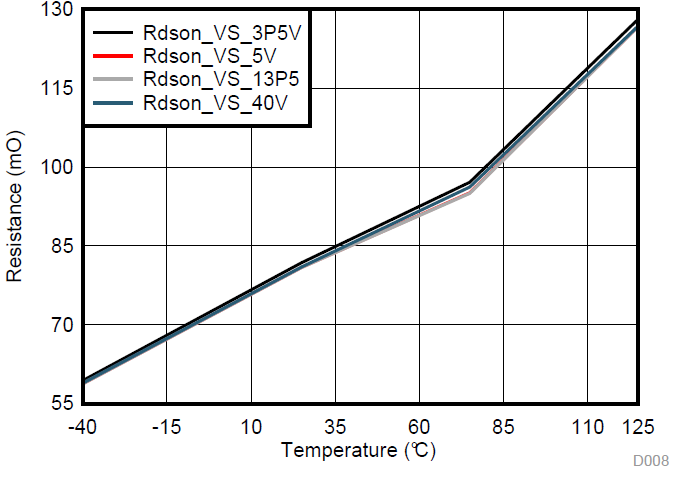SLVAEZ0 November 2020 TPS1H000-Q1 , TPS1H100-Q1 , TPS1H200A-Q1 , TPS1HA08-Q1 , TPS1HB35-Q1 , TPS2H000-Q1 , TPS2H160-Q1 , TPS2HB16-Q1 , TPS2HB50-Q1 , TPS4H000-Q1 , TPS4H160-Q1
1.3 Varying RDSON
The on-resistance, RDSON , is the inherent resistance of the High-Side Switch device. This value depends on the temperature of the device, as well as whether the switch is in the saturation or linear region. Since RDSON is a factor in calculating an accurate power pulse and calculating the junction temperature relies heavily on inputting an accurate power pulse, varying RDSON as it varies due to temperature is an important factor to consider. The power dissipated by the switch, PDISS, can be calculated as the product of the current through the switch, IDS, and the voltage across the switch, VDS.

However, in the linear region it is easier to calculate the power dissipated by the switch, PDISS, as the product of the squared current through the switch, IDS, and the on-resistance of the switch, RDSON.

RDSON varies as a function of temperature, as Figure 1-2 from the TPS1H100 data sheet shows in the Typical Characteristics plot of RDSON.
 Figure 1-2 Characteristic Plot of
RDSON of TPS1H100
Figure 1-2 Characteristic Plot of
RDSON of TPS1H100To account for this change in temperature, the PSpice model must recursively take into account the maximum temperature, and then recalculate using the corresponding RDSON for that temperature. Since the RDSON decreases for decreasing temperature, the RDSON will eventually converge onto a realistic RDSON value instead of the worst-case RDSON in the data sheet. The equation of the plot can be approximated as a line as Equation 6 shows.

Where m is the slope of the line and b is the value of RDSON at 0°C. To account for this change in RDSON, the PSpice thermal model recursively measures the simulated junction temperature. First, the model inputs the worst-case RDSON, located in the electrical characteristics section of the high-side switch data sheet. After this initial junction temperature value is calculated, the model iterates until the temperature and RDSON converges. Figure 1-3 illustrates this behavior.
 Figure 1-3 Block Diagram of Model
Figure 1-3 Block Diagram of ModelWith the implementation of the thermal behavior implemented within the PSpice model, the recursive calculation is automatically taken care of in the software.